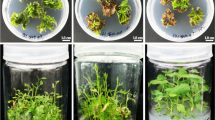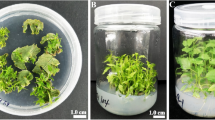Abstract
Although triploid Populus varieties have been used widely in timber and pulpwood production, the performance of economic traits in Populus with higher ploidy levels remains unknown due to a lack of germplasms with higher ploidy. In this study, we first successfully induced hexaploids in Populus by treating triploid leaf explants with colchicine in vitro. In total, 32 hexaploids were produced. The frequency of hexaploids was significantly affected by the interaction between colchicine concentration and exposure time. The highest hexaploid induction efficiency was 16.89% (± 2.26), which was achieved by treating explants with 0.04% colchicine for 7 days. Compared to triploids, hexaploids had thinner epidermal hair, larger stomata and protoplasts, and fewer chloroplasts, indicating that significant phenotypic changes accompanied an increase in ploidy level. These hexaploids are valuable for investigating the performance of economic traits in Populus with higher ploidy levels and have the potential to be used as parents to produce new tetraploid and pentaploid germplasms in Populus breeding programs.





Similar content being viewed by others
Abbreviations
- MS:
-
Murashige and Skoog (1962) basal medium
- IBA:
-
Indolebutyric acid
- BA:
-
6-Benzyladenine
- TDZ:
-
Thidiazuron (N-phenyl-N’-1,2,3-thiadiazol-5-ylurea)
- MOPS:
-
4-Morpholinepropane sulfonate
- PVP:
-
Polyvinylpyrrolidone
- CPW:
-
Cell protoplast washing medium
- MES:
-
4-Morpholine ethane sulfonic acid
- BSA:
-
Bovine serum albumin
- ANOVA:
-
Analysis of variance
- LSD:
-
Least significant difference
- SE:
-
Standard error
- SEM:
-
Scanning electron microscopy
- PI:
-
Propidium iodide
References
Balao F, Herrera J, Talavera S (2011) Phenotypic consequences of polyploidy and genome size at the microevolutionary scale: a multivariate morphological approach. New Phytol 192:256–265
Baumeister G (1980) Beispiele der polyploidie-Züchtung. Allg Forestz 35:697–699
Cai X, Kang XY (2011) In vitro tetraploid induction from leaf explants of Populus pseudo-simonii Kitag. Plant Cell Rep 30:1771–1778
Campos JMS, Davide LC, Salgado CC, Santos FC, Costa PN, Silva PS, Alves CCS, Viccini LF, Pereira AV (2009) In vitro induction of hexaploid plants from triploid hybrids of Pennisetum purpureum and Pennisetum glaucum. Plant Breed 128:101–104
De Storme N, Mason A (2014) Plant speciation through chromosome instability and ploidy change: cellular mechanisms, molecular factors and evolutionary relevance. Curr Plant Biol 1:10–33
Den Nijs TPM, Peloquin SJ (1977) 2n gametes in potato species and their function in sexual polyploidization. Euphytica 26:585–600
Dubcovsky J, Dvorak J (2007) Genome plasticity a key factor in the success of polyploid wheat under domestication. Science 316:1862–1866
Einspahr DW (1984) Production and utilization of triploid hybrid aspen. Iowa State J Res 58(4):401–409
Finigan P, Tanurdzic M, Martienssen RA (2012) Origins of novel phenotypic variation in polyploids. In: Soltis PS, Soltis DE (eds) Polyploidy and genome evolution. Springer, Berlin, pp 57–76
Frearson EM, Power JB, Cocking EC (1973) The isolation, culture and regeneration of Petunia leaf protoplasts. Dev Biol 33:130–137
Galbraith DW, Harkins KR, Maddox JM, Ayres NM, Sharma DP, Firoozabady E (1983) Rapid flow cytometric analysis of the cell cycle in intact plant tissues. Science 220:1049–1051
Guo WW, Deng XX (1999) Intertribal hexaploid somatic hybrid plants regeneration from electrofusion between diploids of Citrus sinensis and its sexually incompatible relative, Clausena lansium. Theor Appl Genet 98:581–585
Huang Z, Xu C, Li Y, Wang PQ, Li Y, Kang XY (2015) Induction of somatic embryogenesis by anther-derived callus culture and plantlet ploidy determination in poplar (Populus × beijingensis). Plant Cell Tiss Organ Cult 120:949–959
James DJ, Mackenzie KAD, Malhotra SB (1987) The induction of hexaploidy in cherry rootstocks using in vitro regeneration techniques. Theor Appl Genet 73:589–594
Kang XY (2016) Polyploid induction techniques and breeding strategies in poplar. In: Mason AS (ed). Polyploidy and hybridization for crop improvement. CRC Press, Boca Raton
Leitch AR, Leitch IJ (2008) Genomic plasticity and the diversity of polyploid plants. Science 320:481–483
Mason AS, Yan G, Cowling WA, Nelson MN (2012) A new method for producing allohexaploid Brassica through unreduced gametes. Euphytica 186:277–287
Miranda M, Motomura T, Ikeda F, Ohgawara T, Saito W, Endo T, Omura M, Moriguchi T (1997) Somatic hybrids obtained by fusion between Poncirus trifoliata (2x) and Fortunella hindsii (4x) protoplasts. Plant Cell Rep 16:401–405
Murashige T, Skoog F (1962) A revised medium for rapid growth and bio assays with tobacco tissue cultures. Physiol Plant 15:473–497
Nilanthi D, Chen XL, Zhao FC, Yang YS, Wu H (2009) Induction of tetraploids from petiole explants through colchicine treatments in Echinacea purpurea L. J Biomed Biotechnol 2009:343485
Pradhan A, Plummer JA, Nelson MN, Cowling WA, Yan G (2010) Successful induction of trigenomic hexaploid Brassica from a triploid hybrid of B. napus L. and B. nigra (L.) Koch. Euphytica 176:87–98
R Development Core Team (2007) R: a language and environment for statistical computing. Austria R Foundation for Statistical Computing, Vienna
Schwartz BM, Harris-Shultz KR, Contreras RN, Hans CS, Jackson SA (2013) Creation of hexaploid and octaploid zoysiagrass using colchicine and breeding. Crop Sci 53:2218–2224
Shi QH, Liu P, Liu MJ, Wang JR, Xu J (2015) A novel method for rapid in vivo induction of homogeneous polyploids via calluses in a woody fruit tree (Ziziphus jujuba Mill.). Plant Cell Tiss Organ Cult 121:423–433
Song SY (2017) Isolation of tetraploid and diploid through plant regeneration from leaf explants of Populus ploidy chimera. dissertation, Beijing Forestry University, Beijing
Song SY, Zhang JQ, Wang J (2015) Preparation and optimization of mesophyll protoplasts of Populus alba × P. berolinensis Yinzhong. Acta Bot Boreal Occident Sin 35(9):1899–1905
Sugiura A, Ohkuma T, Choi YA, Tao R (2000) Production of nonaploid (2n = 9x) Japanese persimmons (Diospyros kaki) by pollination with unreduced (2n = 6x) pollen and embryo rescue culture. J Am Soc Hortic Sci 125(5):609–614
Tamura M, Tao R, Yonemori K, Utsunomiya N, Sugiura A (1998) Ploidy level and genome size of several Diospyros species. J Jpn Soc Hortic Sci 67(3):306–312
Thao NTP, Ureshino K, Miyajima I, Ozaki Y, Okubo H (2003) Induction of tetraploids in ornamental Alocasia through colchicine and oryzalin treatments. Plant Cell Tissue Organ Cult 72:19–25
Udall JA, Wendel JF (2006) Polyploidy and crop improvement. Crop Sci 46:3–14
Van de Peer Y, Maere S, Meyer A (2009) The evolutionary significance of ancient genome duplications. Nat Rev Genet 10:725–732
Wang J, Li DL, Kang XY (2012a) Induction of unreduced megaspores with high temperature during megasporogenesis in Populus. Ann For Sci 69:59–67
Wang TY, Guo QS, Wang T (2012b) Karyotype analysis of 21 Chrysanthemum cultivars for medicine. J Nanjing Agric Univ 35(6):13–18
Wang J, Shi L, Song S, Tian J, Kang X (2013) Tetraploid production through zygotic chromosome doubling in Populus. Silva Fenn 47(2):id932
Wang X, Cheng Z-M, Zhi S, Xu F (2016) Breeding triploid plants: a review. Czech J Genet Plant Breed 52(2):41–54
Wang J, Huo BB, Liu WT, Li DL, Liao L (2017) Abnormal meiosis in an intersectional allotriploid of Populus L. and segregation of ploidy levels in 2x × 3x progeny. PLoS ONE 12(7):e0181767
Winton L, Einspahr DW (1970) Tetraploid aspen production using unreduced triploid pollen. Forest Sci 16:180–182
Xu C, Huang Z, Liao T, Li Y, Kang XY (2016) In vitro tetraploid plants regeneration from leaf explants of multiple genotypes in Populus. Plant Cell Tiss Organ Cult 125:1–9
Yao CL, Pu JW (1998) Timber characteristics and pulp properties of the triploid of Populus tomentosa. J Beijing For Univ 20:18–21
Zhu ZT, Lin HB, Kang XY (1995) Studies on allotriploid breeding of Populus tomentosa B301 clones. Sci Silvae Sin 31:499–505
Zhu ZT, Kang XY, Zhang ZY (1998) Studies on selection of natural triploid of Populus tomentosa. Sci Silvae Sin 34:22–31
Acknowledgements
This work was supported by the National Natural Science Foundation of China (Grant No. 31470662) and the program from the Beijing Municipal Education Commission (Grant No. CEFF-PXM2018_014207_000024). The English in this document has been checked by at least two professional editors, both native speakers of English. For a certificate, please see: http://www.textcheck.com/certificate/D74xMK.
Author information
Authors and Affiliations
Contributions
JW conceived and designed research. WL, SS and BH conducted experiments. YZ and DL analyzed data and prepared figures. WL and JW wrote the manuscript. All authors read and approved the manuscript.
Corresponding author
Ethics declarations
Conflict of interest
The authors declare that they have no competing interests.
Additional information
Communicated by Sergio J. Ochatt.
Rights and permissions
About this article
Cite this article
Liu, W., Zheng, Y., Song, S. et al. In vitro induction of allohexaploid and resulting phenotypic variation in Populus. Plant Cell Tiss Organ Cult 134, 183–192 (2018). https://doi.org/10.1007/s11240-018-1411-z
Received:
Accepted:
Published:
Issue Date:
DOI: https://doi.org/10.1007/s11240-018-1411-z




